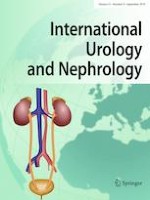Published in:

01-09-2019 | Urology - Original Paper
Hydrogen sulfide-induced relaxation of the bladder is attenuated in spontaneously hypertensive rats
Authors:
Suo Zou, Takahiro Shimizu, Masaki Yamamoto, Shogo Shimizu, Youichirou Higashi, Motoaki Saito
Published in:
International Urology and Nephrology
|
Issue 9/2019
Login to get access
Abstract
Purpose
To compare hydrogen sulfide (H2S)-induced relaxation on the bladder between normotensive and spontaneously hypertensive rat (SHR), we evaluated the effects of H2S donors (GYY4137 and NaHS) on the micturition reflex and on the contractility of bladder tissues. We also investigated the content of H2S and the expression levels of enzymes related to H2S biosynthesis [cystathionine β-synthase (CBS), 3-mercaptopyruvate sulfurtransferase (MPST), and cysteine aminotransferase (CAT)] in the bladder.
Methods
Eighteen-week-old male normotensive Wistar rats and SHRs were used. Under urethane anesthesia, the effects of intravesically instilled GYY4137 (10−8, 10−7 and 10−6 M) on the micturition reflex were evaluated by cystometry. The effects of NaHS (1 × 10−8–3 × 10−4 M) were evaluated on carbachol (10−5 M)-induced pre-contracted bladder strips. Tissue H2S content was measured by the methylene blue method. The expression levels of these enzymes were investigated by Western blot.
Results
GYY4137 significantly prolonged intercontraction intervals in Wistar rats, but not in SHRs. NaHS-induced relaxation on pre-contracted bladder strips was significantly attenuated in SHRs compared with Wistar rats. The H2S content in the bladder of SHRs was significantly higher than that of Wistar rats. CBS, MPST and CAT were detected in the bladder of Wistar rats and SHRs. The expression levels of MPST in the SHR bladder were significantly higher than those in the Wistar rat bladder.
Conclusion
H2S-induced bladder relaxation in SHRs is impaired, thereby resulting in a compensatory increase of the H2S content in the SHR bladder.